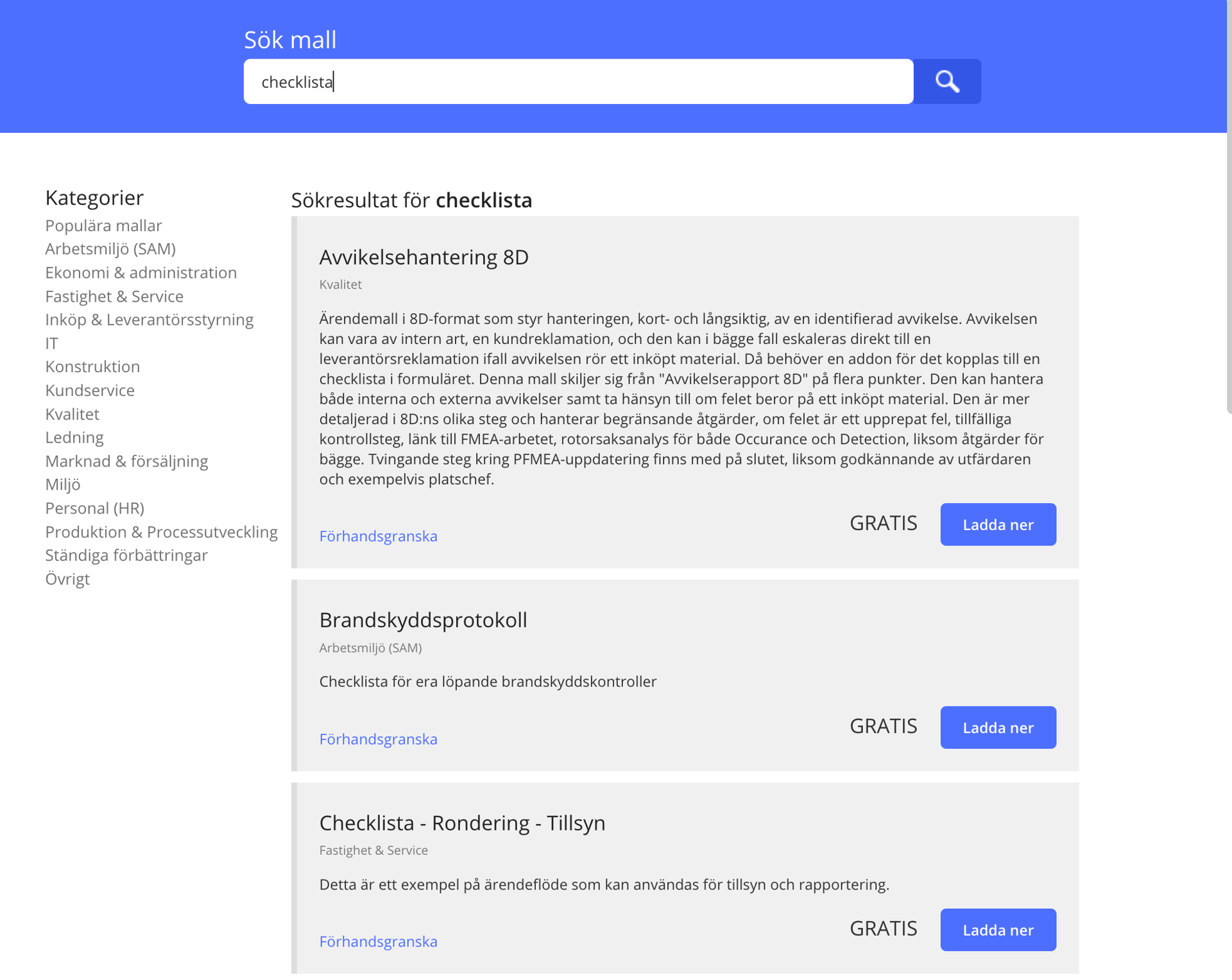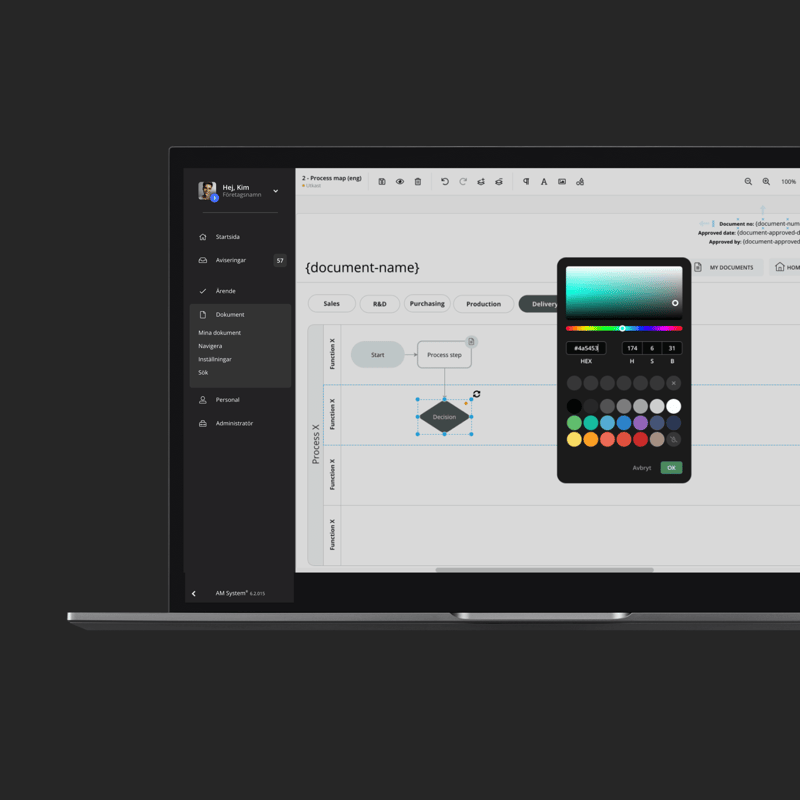Article
Self-monitoring: Documenting and structuring with AM System
-
 Editorial team
Editorial team
-
- Case Management
- 4 min reading

We know that self-monitoring is an important part of your everyday life. That's why we think it should run as smoothly as possible. With AM System's case management solution, you document your self-monitoring and keep track of who does what. Working with case management in AM System works equally well on computers, tablets and mobile phones. Template or create forms from scratch? It's your choice. We have templates for self-monitoring (and for much more if you need it.)
Why self-monitoring with AM System?
With case management from AM System, you can both plan and document the work of self-monitoring. Since the solution is cloud-based, routines and protocols are always available to the person performing a self-audit. In addition, users can report the result of the check even if they are not in the office, for example if someone has taken a temperature measurement when the goods are delivered to the customer. Log in via your mobile and report directly.
Automatic reminders help you remember even checks that are not due on a daily basis. If you need to show an overall result of your self-checks, just use the built-in statistics function. Build your own template or use one of our ready-made self-monitoring templates and you're on your way.
What is self-monitoring?
There are regulations and laws on self-regulation in several different areas, such as food, environment and construction. What they all have in common is that they are designed to protect people or the environment. By carrying out a self-assessment, you check that you are working in a way that complies with rules and guidelines (and you also discover what you need to do differently).
As the word suggests, self-monitoring means that you carry out the monitoring yourself. The exception is self-inspection in construction, where many self-inspections have to be done by someone other than the person who did the work or by external experts (read more below).
Self-monitoring programmes usually work best if they are a natural part of your daily work (sometimes it is also a requirement that you carry out self-monitoring on certain things on a daily basis). Evaluate your self-monitoring work regularly so that you know it is working as intended.The Public Health Agency of Sweden recommends that you ask yourself these questions:
- What procedures are in place?
- Are the procedures known?
- Are the procedures applied?
- What is the result of the procedures?

Self-monitoring: Food
The Food Act states that anyone who handles food professionally - from e.g. waterworks and wholesalers to restaurants and sausage kiosks - must ensure that the food is safe to eat. This includes, for example, ensuring that food is properly labeled.
Food hygiene is a key word in this context. To ensure that you maintain food hygiene, you should have procedures and controls in place. You should develop a system that is suitable for your business, so that it is adapted to what you do and the size of your business. The system should be based on the principles of HACCP (Hazard Analysis and Critical Control Points).
HACCP self-checking
This is how a HACCP analysis can work:
- Write a product description.
- Describe all the steps in how you handle the food. How do you receive the product, how do you store it, how do you process it, how do you sell or deliver it...
- Go through all the steps from point 2 and identify possible health hazards. Include all types of hazards: microbiological, physical, chemical and allergenic.
- Make a risk assessment for each of the hazards you found in point 3.
- Develop improvement actions.
- Determine where the critical control points are.
- Determine critical limits for each critical control point. Follow any rules and guidelines or ask someone with experience.
- Develop a system to monitor each critical control point (e.g. a protocol for regular temperature measurements).
- Make a plan for what to do if something does go wrong (e.g. "if fridge 1 breaks down, we can move goods like this to fridge 2, as long as the temperature in fridge 1 is still below this critical limit"). Make sure the plan says who will do what, when it will be done and how.
- Write procedures for documenting and evaluating your work.
Critical limit = A limit where something goes from being acceptable to being unacceptable, for example a temperature in a freezer or an amount of chlorine in drinking water.
Critical control point = A point at which it is necessary to use a control measure to ensure that a foodborne hazard can be prevented, eliminated or reduced.
Own-check: Environmental Code
The Environmental Code states that anyone who "conducts activities or takes measures" that could harm human health or affect the environment must prevent this from happening. This involves both planning in advance and checking during and after the work.
The Environmental Code ( Chapter 26, Section 9) and theSwedish Environmental Protection Agency's General Advice on Self-Inspection are the basis for your self-monitoring program. If you have an activity that requires a permit or notification, you must also comply withthe Ordinance (1998:901) on self-monitoring by operators, which places greater demands on your documentation.
Your self-monitoring program must be adapted to your business. If you have a large business that risks seriously damaging the environment if something goes wrong, you need more advanced self-monitoring than if you have a small and relatively harmless business - if we take a slightly extreme example, a nuclear power plant needs much more extensive self-monitoring than a car repair shop.
Own-check: Construction
Self-inspection underthe Planning and Building Act is different from other self-inspections. You can carry out self-inspection on some parts of the work yourself, but many works must be inspected by certified experts or at least someone other than the person who carried out the work. Examples of things that need to be checked by others are welds and chimneys.
Before construction work begins, the building committee draws up an inspection plan. This sets out what needs to be checked and documented in order for the building work to be approved. The developer is responsible for ensuring that there is a control plan and that it is followed.
Get a demo
Ready to make work easier - and more enjoyable?
Want to see for yourself how AM System can make a difference for you? Book a demo and discover how easy it is to create structure, efficiency, and seamless workflows in your daily operations.
